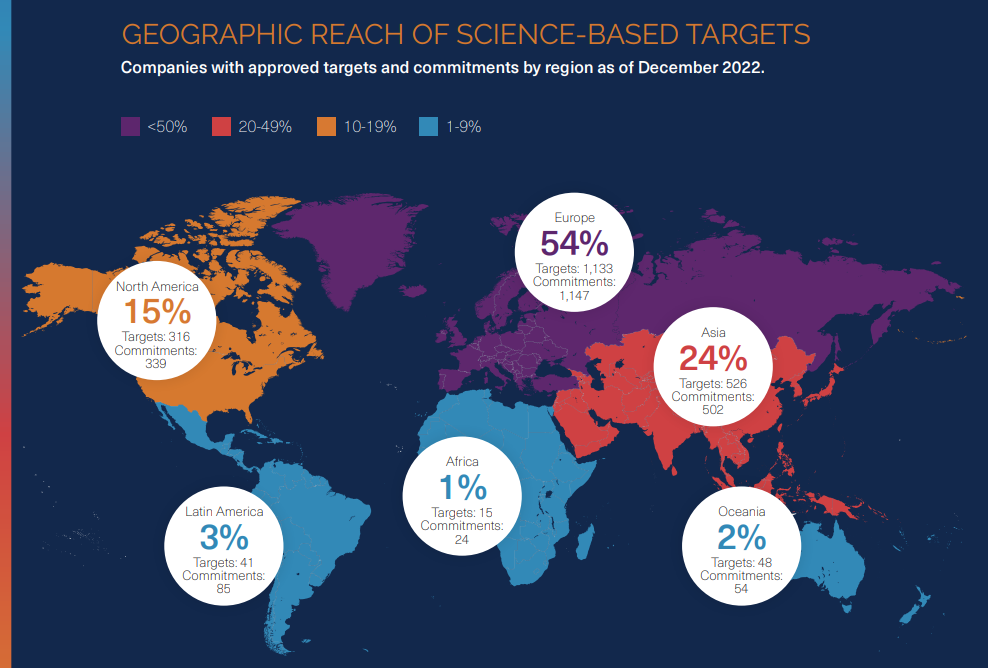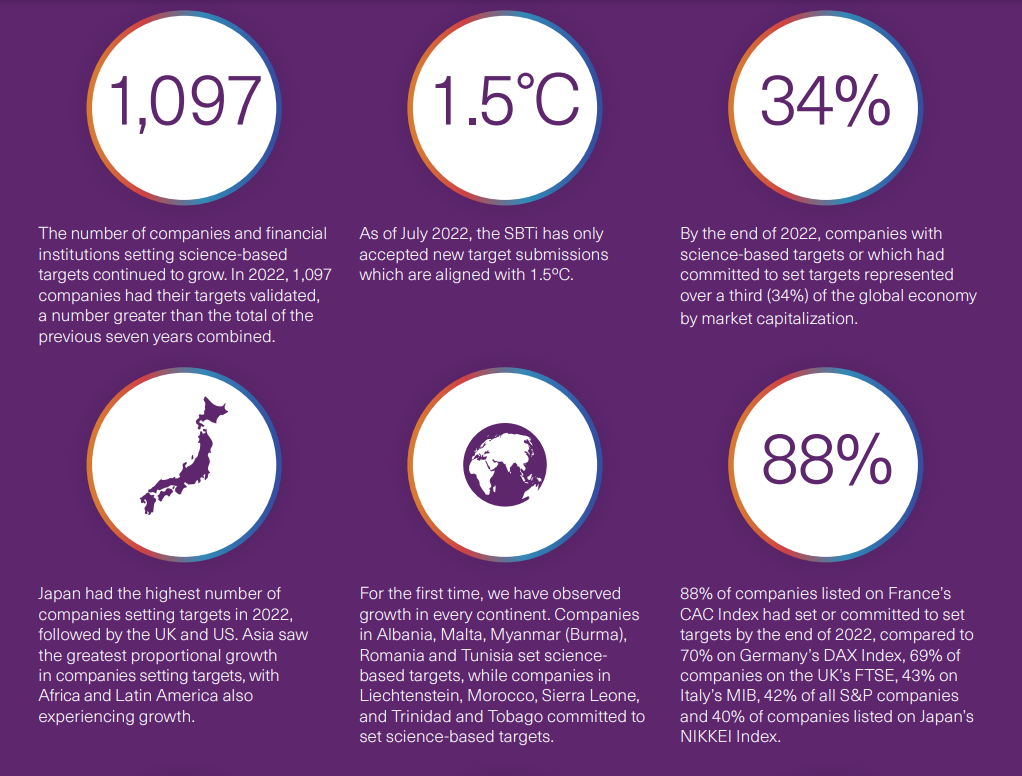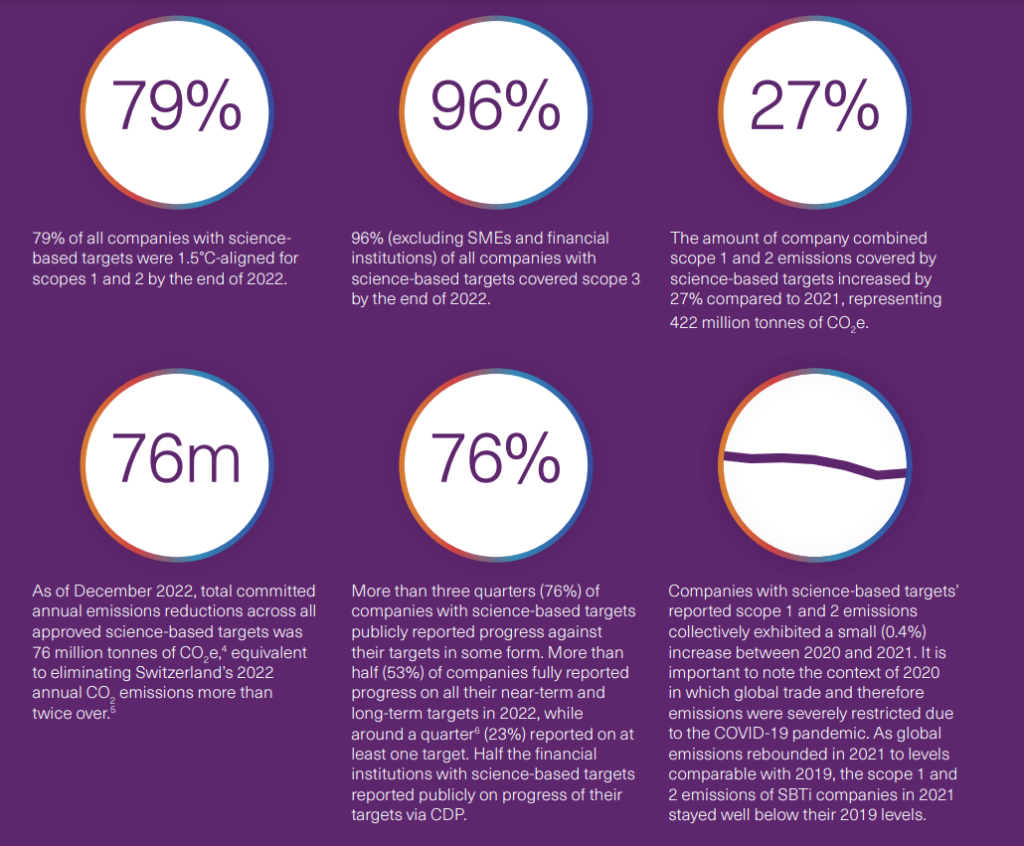
Contents
In the face of catastrophic impacts of climate change, the Science Based Targets Initiative (SBTi) stands as a testament to the power of collective action. With SBTi’s scientifically grounded framework, organizations are empowered to set ambitious emissions reductions targets, carving paths toward environmental stewardship that resonate with the urgency of our times.
This article dives into the true potential of aligning with the SBTi- a strategy that fosters environmental sustainability and drives sustainable growth. As a global body, Science Based Targets Initiative (SBTi) plays a crucial role in defining a clear and defined pathway towards sustainable business practices, aligning with the goals of the global compact to mitigate climate change.
The Science Based Targets Initiative (SBTi), as outlined in the Net-Zero Standard PDF, is a joint venture that guides companies in setting and achieving ambitious greenhouse gas reduction targets. These targets are not arbitrary; they are firmly rooted in scientific evidence and methodologies to meet the goals of the Paris Agreement of 2015.
SBTi provides tools and guidance to corporations and organizations to ensure that their net zero targets are both aggressive and achievable, steering businesses towards a trajectory that significantly limits global temperature rise.
The SBTi was formed as a collaboration between several global organizations, including the Carbon Disclosure Project (CDP), the United Nations Global Compact (UNGC), the World Resources Institute (WRI), and the World Wide Fund for Nature (WWF).
This partnership reflects a shared recognition of the urgent need to address climate change through actionable and science-based strategies. Since its inception, the SBTi has evolved, incorporating the latest scientific findings and adapting its guidelines to ensure the most effective and up-to-date approaches are available for companies committed to reducing their carbon footprint.
The real question that we need to be asking is how effective these approaches and strategies formulated by SBTi have been in achieving their goals and objectives?
Well, the true impact of SBTi is evident in its growing influence and adoption by the business community. As per WRI’s initiative page, an increasing number of companies worldwide are aligning their greenhouse gas reduction goals with the SBTi’s stringent criteria. These commitments are supported by extensive data, studies, and statistical analyses, reflecting the initiative’s effectiveness in driving meaningful change. Its adoption across different regions reflects a growing international consensus on the necessity of a clearly defined pathway towards sustainability.
Let us check the facts and figures around this taken directly from SBTi’s 2021 progress report:

Science-based target setting involves creating emissions reduction targets in alignment with the level of decarbonization required to limit global warming to 1.5°C above pre-industrial levels. These emission reduction targets encompass not just a company’s direct emissions but also their value chain and indirect emissions, ensuring a comprehensive approach to sustainability.
When a company sets a science-based target (SBT), it commits to an ambitious climate target backed by robust scientific evidence. This process aligns with the latest climate science, ensuring that the targets are not only aspirational but also practical and measurable. By doing so, businesses make a tangible contribution to reducing global greenhouse gas emissions, which is critical in the fight against climate change.
The Global Carbon Project reported that global CO2 emissions from fossil fuel combustion reached approximately 36.7 gigatonnes in 2019. This is a significant amount and highlights the urgent need for global efforts to reduce carbon emissions. Aligning with SBTs helps companies contribute meaningfully to lowering these greenhouse gas emissions further.

Infographic summary of SBTi’s progress with 1,097 validated company targets for climate action.

Overview of SBTi’s 2022 impact with 96% scope 3 coverage and 76m tonnes CO2e reduction (Source: SBTi)
IKEA has science-based emissions reduction targets in place. Their goal is to further reduce more emissions than the IKEA value chain emits by 2030, aiming for a net zero or positive impact on the climate.
In Europe, companies like Unilever and Volvo have committed to SBTi, aligning their corporate strategies with the Paris Agreement goals. Unilever has an approved science-based target to reduce their Scope 1 and Scope 2 emissions by 100% by 2030, compared to their 2015 figures. Volvo has developed it’s own pathway towards the 1.5⁰C target for trucks and buses, with a targeted emissions reduction of 40% per vehicle km by 2030. In Asia, conglomerates like Samsung have joined the initiative, showcasing its global economy and relevance across different economic landscapes.
The Intergovernmental Panel on Climate Change (IPCC) plays a critical role in providing the scientific foundation upon which the SBTi bases its targets. This relationship ensures that the targets remain aligned with the most current climate science.
Different industries face unique challenges in emissions reduction. For instance, in the energy sector, SBTs might focus on transitioning to renewable energy sources, while in manufacturing, the emphasis could be on energy efficiency and sustainable materials.
Collaboration across industries and sectors is essential in this endeavor. Initiatives like the RE100, which brings together businesses committed to 100% renewable electricity, demonstrate how collective action can amplify the impact of individual science-based targets.
A key component of the SBTi’s framework is its Net Zero Standard, which offers sector-specific guidance for businesses aiming to achieve net zero GHG emissions. This standard defines and promotes best practices, ensuring that corporate net zero targets align with the ambition of the Paris Agreement to limit global warming.
For in-depth study of this topic, check our blog – Complete Guide To Achieving Net-Zero Targets
Aligning with the SBTi is akin to setting out on a strategic voyage towards sustainability, and the roadmap is clear: set rigorous science-based targets, diligently monitor and report progress, and stay agile to navigate through challenges.
Publicly commit to setting science-based targets, signaling to stakeholders your dedication to a net zero economy. Engage with stakeholders and educate them on the long-term benefits of sustainability and science-based target setting net zero targets.
Conduct a comprehensive emission inventory in line with the GHG Protocol and draft a roadmap to meet the targets in line with climate science.
Complexity in data collection and target setting methods could pose a challenge in this step. Invest in reliable data management systems and seek expert consultation to tackle this.
Obtain official validation for your targets from the SBTi and report on progress to ensure transparency. Do not be detered by the rigorous standards for official validation of sustainability reports from SBTi. To be successful here, adhere to best practice and maintain clear documentation of all sustainability efforts.
Integrate emission reduction strategies across business operations, from energy efficiency to supply chain optimization. Aligning the entire operation in accordance with the ambitious climate action targets could be difficult to start with. Kick start with pilot projects, scale successful initiatives, and foster a culture of innovation.
Regularly monitor progress and adjust strategies as necessary to stay on course with the set targets. The real struggle here is staying adaptive to emerging science and market changes. Establish and invest in a flexible approach and continuous improvement mechanism.
Talk about your progress and wins to encourage others to take similar steps. It’s tough to stand out in a competitive market. But if you lead by example, you can spark change across your industry. Your actions can influence others and spread positive practices wider.
For further guidance on each of these steps and to access detailed resources, visit the official SBTi website: Set a Science-Based Target. This site provides the tools and information needed to ensure that your company wide emissions reductions and sustainability goals are grounded in the latest climate science and meet global best practices.
As sustainability consultants, we have seen firsthand how tech is revolutionizing our approach to climate commitments. State-of-the-art carbon accounting tools such as the North Star Carbon Management tool are reshaping how companies tackle emissions.
The International Energy Agency (IEA) reports a whopping USD $50 billion is being poured into digital electricity and software. This investment surpasses that in gas-fired power generation, indicating a significant shift towards digital infrastructure in the energy sector. It’s a clear signal that the world is serious about harnessing tech for sustainable outcomes.
We’re moving beyond ticking boxes to creating a path that others will want to follow. Here are some shining examples of companies achieving ambitious climate targets with the help of SBTi’s guidance.
Corporations are crucial in driving climate efforts. A company’s pledge to limit warming and chase a net zero future is just the starting line. The real race is in the relentless, meticulous tracking of progress—ensuring that every strategy employed is not just a checkmark on a sustainability checklist, but a stride towards actual environmental impact.
This is where cutting-edge tools like the North Star Carbon Management tool come into play, offering a compass for companies and financial institutions to navigate the complex terrain of carbon accounting and management.
Unique in its design, the North Star Carbon Management tool equips business leaders with clarity, marrying data-driven insights with forward-thinking sustainability goals. It’s a trendsetter, challenging enterprises to look beyond baseline compliance and redefine their benchmarks, aligning with the evolving nuances of climate science.
Futuristic companies do not simply adapt to new standards; they set them, influencing the entire financial landscape and carving out a sustainable niche that others aim to occupy.
The Science Based Targets initiative (SBTi) is steering the ship towards a sustainable horizon. Imagine a world where every business, from tech giants to local start-ups, aligns its carbon footprint with a set science based target that benchmarks the sharpest climate science. That’s the future SBTi is crafting, and it’s electrifying.
Thanks to SBTi’s unique perspectives companies aren’t merely setting targets; they’re transforming their entire value chain, proving that big ambitions can lead to groundbreaking changes.
The next big trend? Financial institutions are joining the party. They’re shaping a new financial landscape by adopting science-based targets where sustainability equals profitability.
As climate science evolves, so do SBTi’s strategies, keeping businesses ahead of the curve. It’s not just about meeting standards; it’s about setting new ones. It’s a thrilling time for sustainability, and SBTi is at the forefront, turning bold visions into real-world actions.
Josh is a renowned sustainability professional with extensive experience in leading sustainability programs and initiatives for large organizations. His expertise is not just limited to consulting; he is also a sought-after public speaker and a college professor. To learn more about him, read about him here – About North Star Carbon Management.